Memory Scaling on Haswell CPU, IGP and dGPU: DDR3-1333 to DDR3-3000 Tested with G.Skill
by Ian Cutress on September 26, 2013 4:00 PM ESTAs mentioned previously, real world testing is where users should be feeling the benefits of spending up to 13x on memory, rather than a synthetic test. A synthetic test exacerbates a specific type of loading to get peak results in terms of memory read/write and latency timings, most of which are not indicative of the pseudo random nature of real-world workloads (opening email, applying logic). There are several situations which might fall under the typical scrutiny of a real world loading, such as video conversion/video editing. It is at this point we consider if the CPU caches are too small and the system is relying on frequent memory accesses because the CPU cannot be fed with enough data. It is these circumstances where memory speed is important, and it is all down to how the video converter is programmed rather than just a carte blanche on all video converters benefitting from memory. As we will see in the IGP Compute section of this review, anything that can leverage the IGP cores can be a ripe candidate for increased memory speed.
Our tests in the CPU Real World section come from our motherboard reviews in order to emulate potential scenarios that a user may encounter.
USB 3.0 Copy Test with MaxCPU
We transfer a set size of files from the 120GB OCZ Vertex3 connected via SATA 6 Gbps on the motherboard to the 240 GB OCZ Vertex3 SSD with a SATA 6 Gbps to USB 3.0 converter via USB 3.0 using DiskBench, which monitors the time taken to transfer. The files transferred are a 9.2 GB set of 7539 files across 1011 folders – 95% of these files are small typical website files, and the rest (90% of the size) are precompiled installers. In an update to pre-Z87 testing, we also run MaxCPU to load up one of the threads during the test which improves general performance up to 15% by causing all the internal pathways to run at full speed.
Results are represented as seconds taken to complete the copy test, where lower is better.
The difference between the slowest and the fastest is around 2%, or 1 second in our test, making the memory have little influence over intended USB speed (at load).
WinRAR 4.2
With 64-bit WinRAR, we compress the set of files used in the motherboard review USB speed tests. WinRAR x64 3.93 attempts to use multithreading when possible, and provides as a good test for when a system has variable threaded load. WinRAR 4.2 does this a lot better! If a system has multiple speeds to invoke at different loading, the switching between those speeds will determine how well the system will do.
Up first, WinRAR 3.93, with results expressed in terms of seconds to compress. Lower is better.
Using the older version of WinRAR shows a 31% advantage moving from 1333 C9 to 3000 C12, although 2400 C9/2666 C10/2800 C11 have a good showing.
WinRAR 4.2 results next:
We see similar results with the later version of WinRAR – here having at least 1866 MHz memory gets above the grade in terms of time, lower CAS Latency helping (1866 C8 / 2133 C9 / 2400 C9 / 2666 C11)
FastStone Image Viewer 4.2
FastStone Image Viewer is a free piece of software I have been using for quite a few years now. It allows quick viewing of flat images, as well as resizing, changing color depth, adding simple text or simple filters. It also has a bulk image conversion tool, which we use here. The software currently operates only in single-thread mode, which should change in later versions of the software. For this test, we convert a series of 170 files, of various resolutions, dimensions and types (of a total size of 163MB), all to the .gif format of 640x480 dimensions. Results shown are in seconds, lower is better.
FastStone is purely a CPU limited benchmark, with little variation and no trend in the results. Discrepancies are part of the statistical variation expected with any result.
Xilisoft Video Converter 7
With XVC, users can convert any type of normal video to any compatible format for smartphones, tablets and other devices. By default, it uses all available threads on the system, and in the presence of appropriate graphics cards, can utilize CUDA for NVIDIA GPUs as well as AMD WinAPP for AMD GPUs. For this test, we use a set of 33 HD videos, each lasting 30 seconds, and convert them from 1080p to an iPod H.264 video format using just the CPU. The time taken to convert these videos gives us our result in seconds, where lower is better.
Similar to WinRAR, to avoid the ultra-slow speeds, anything above 1866 MHz seems to be the right way to go here.
Video Conversion - x264 HD Benchmark
The x264 HD Benchmark uses a common HD encoding tool to process an HD MPEG2 source at 1280x720 at 3963 Kbps. This test represents a standardized result which can be compared across other reviews, and is dependent on both CPU power and memory speed. The benchmark performs a 2-pass encode, and the results shown are the average frame rate of each pass performed four times. Higher is better this time around.
The higher frequency memory performs the best, but to get at least 5% speed up, DDR3-1866 comes along again.
For whatever reason the 1333 C9 and 3000 C12 get a bad showing, but it seems as long as we avoid 1333 C9, any speed is reasonable for a 5-6% increase.
TrueCrypt v7.1a AES
One of Anand’s common CPU benchmarks is TrueCrypt, a tool designed to encrypt data on a hard-drive using a variety of algorithms. We take the program and run the benchmark mode using the fastest AES encryption protocol over a 1GB slice, calculating the speed in GB/s. Higher is better.
Similar to FastStone, there is nothing to differentiate the results. The only oddball here is technically our slowest memory speed: 1333 C9.


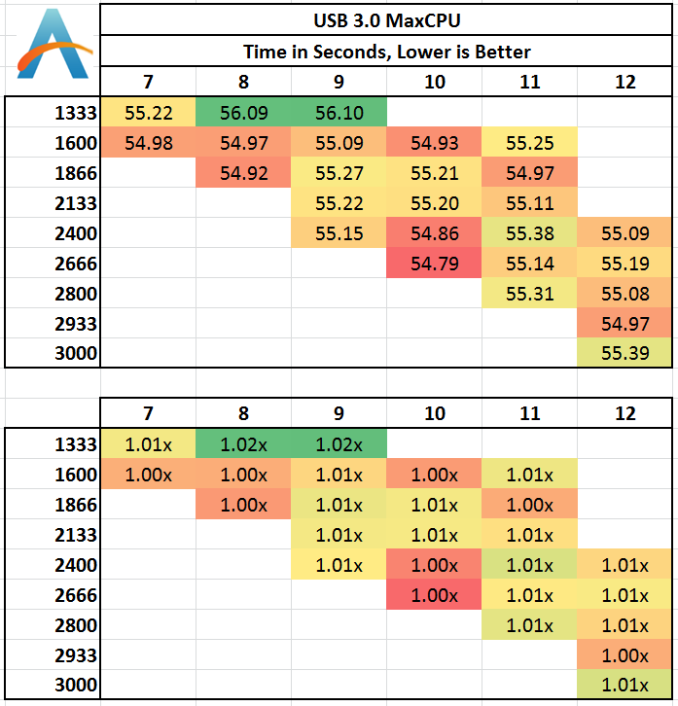

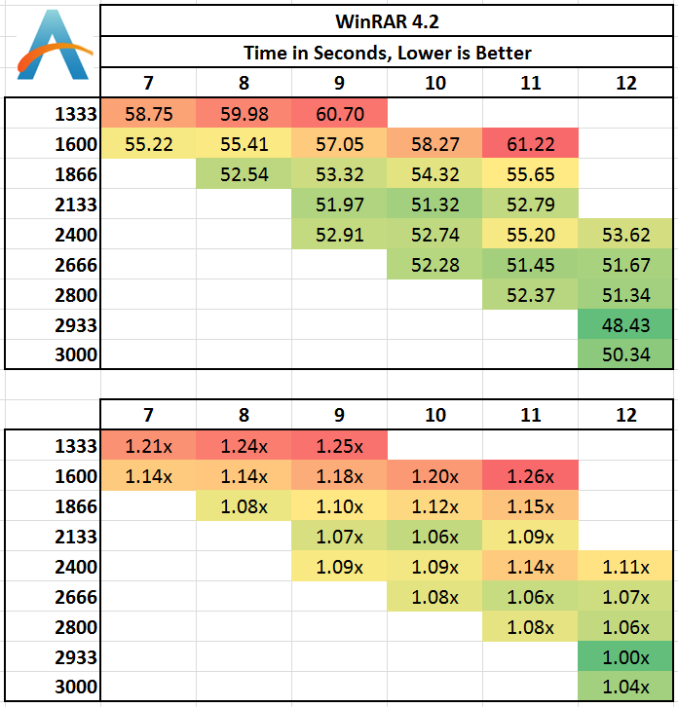
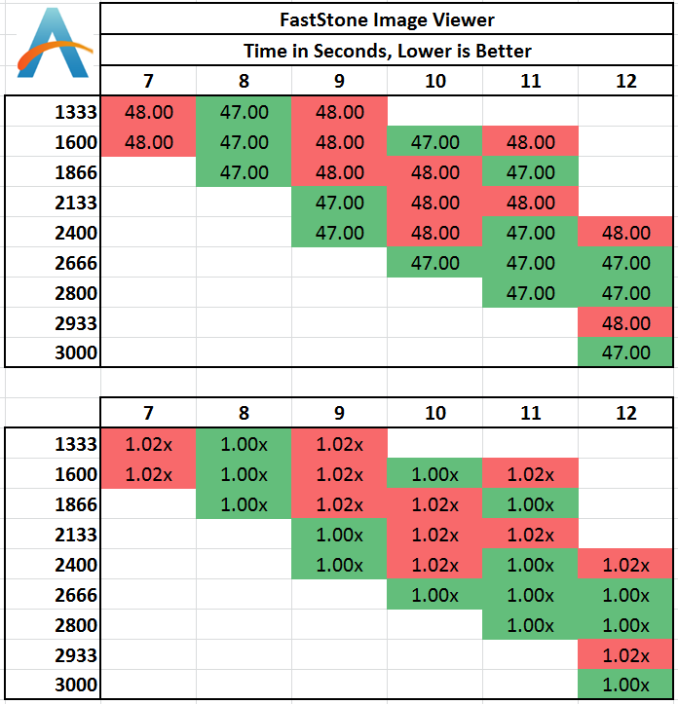
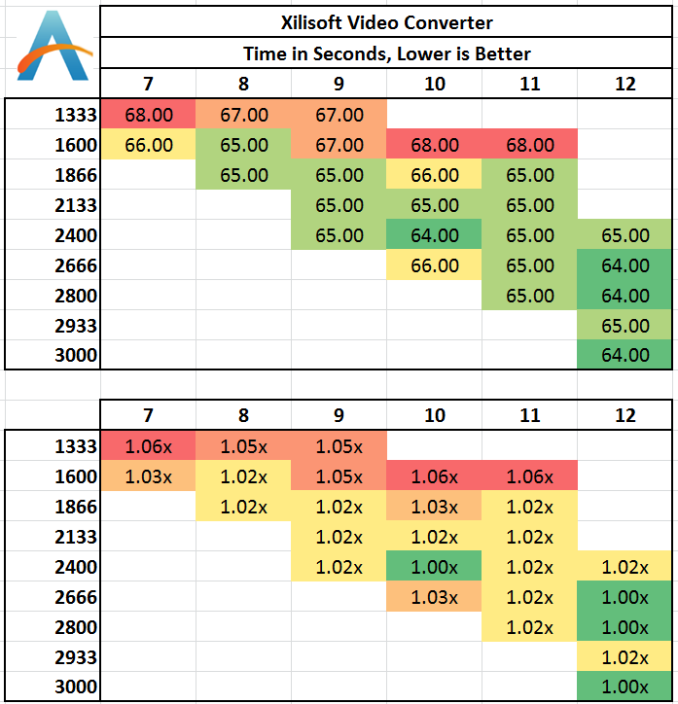
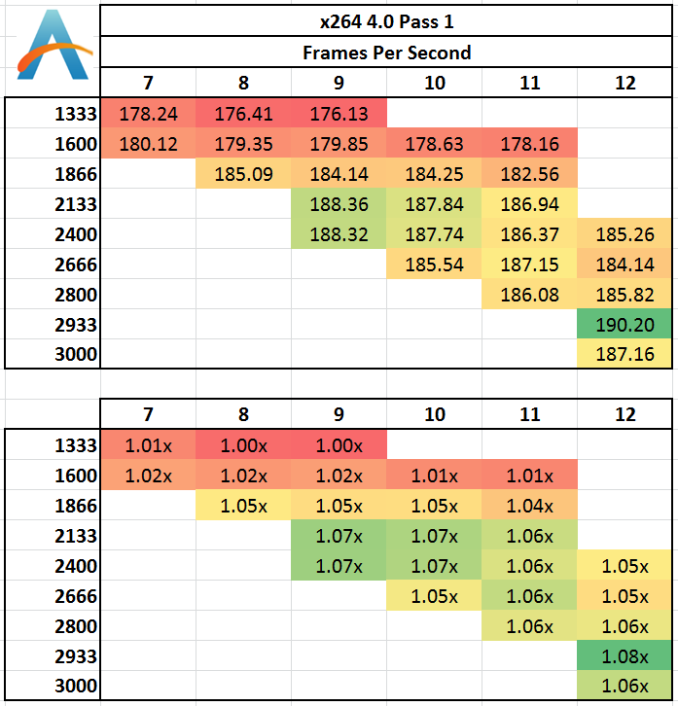
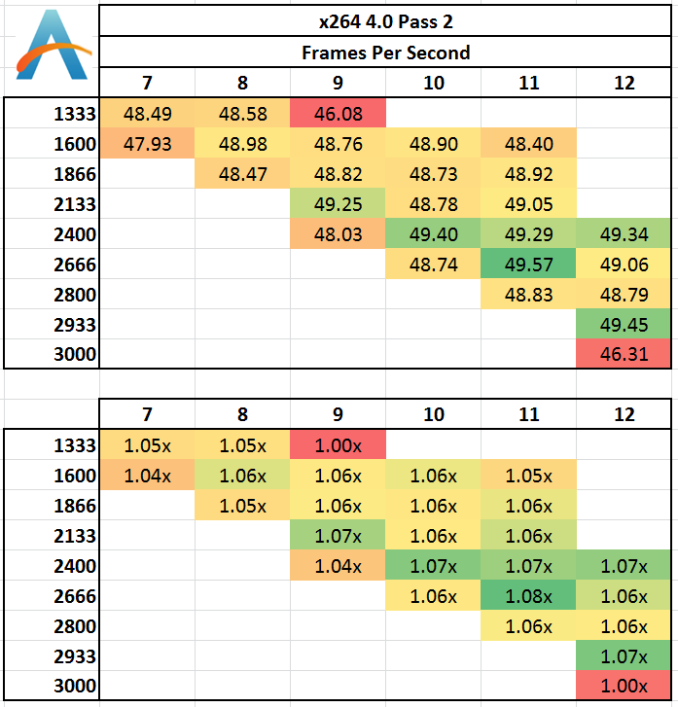
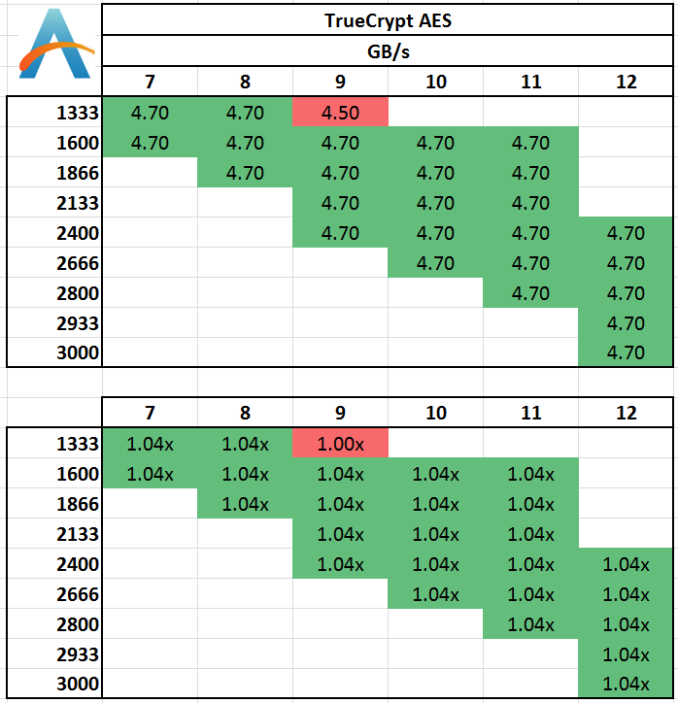








89 Comments
View All Comments
HerrKaLeun - Saturday, September 28, 2013 - link
This was a good review. But I see one major problem for practiacl applications:Whoever cares about performace, doesn't use 8 GB of memory in the year 2013.
Even for a cheap home-built (no gaming, no CAD etc.) I used 16 GB a year ago, which cost only ~$70. when I run multiple applications in parallel (who doesn't?) W7/8 easily uses all memory for cache. Even with an SSD this is a speed advantage.
So for real world applications (running virus scan in parallel to work, 18 browser windows, watching movies etc) 8 GB re easily used up.
I would imagine a 16 GB PC (let's say ~$100) runs circles around the $700 8 GB PC in the real world.
Right now I run MSE and Malwarebytes while just using IE for browsing and I have none of my 16 GB left. The computer is not sluggish at all. I'm not sure how 8 GB RAM would work out.
One could argue most applications don't require that much memory, but running virusscan frequently should be done by all users.
I think this test should be repeated with either 16 GB or 24 GB for triple-channel platform. People interested in a few % more, also need more RAM.
Wwhat - Sunday, September 29, 2013 - link
@HerrKaLeun you say who doesn't use more than 8GB? and say you got 16GB for about 70 dollars, but this article covers a lot of extremely highly speced RAM that as stated is quite expensive, and if you bought 8GB for several hundred dollars you aren't going to supplement it with cheap high-latency low speed off-the-shelf stuff obviously.malphadour - Sunday, September 29, 2013 - link
HerrKaleun you are talking rubbish!! I have an X58 running 6gb ram and I never get anywhere near flooding it. 8GB is more tha ample for 99% of users out there. I recently built a 16gb ram rig for one of our engineers because he demanded it. To prove a point I benchmarked all our software (which includes a juicy construction CAD package) and recorded no more than a 3% performance increase going to 16gb and I put most of that down to going from single channel 8gb stick to dual channel for the 16gb. We tested render times, large drawing copies plus program open and close times with lots every peice of software on the machine running. His argument was the same as yours, and incorrect. Hardware is way ahead of the curve at the moment vs software and it will be a while before the everyday user "needs" more than 8gb.Wwhat - Monday, September 30, 2013 - link
To be fair, I hear battlefield 4 has as suggested setup at least 8GB.Like always the more RAM people on average have the more software starts to require.
ShieTar - Monday, September 30, 2013 - link
"So for real world applications (running virus scan in parallel to work, 18 browser windows, watching movies etc) 8 GB re easily used up."Because Windows will fill up all the Memory it has before even starting any garbage collection algorithms. Even today, you should be able to do all those trivial applications on 2GB of memory.
And anybody doing serious work or gaming will probably not run two major software packages at the same time. A few background programs (depending on how paranoid your companies IT department is), and a few trivial programs like browser, word processor, excel, PDF may run on the side and use up 1GB to 2GB. But nobody in his right mind will start processing of huge images in Photoshop while keeping his CAD models open in CATIA. A few nutjobs out there may run 16 installations of WoW on 16 screens with the same PC, but thats not really relevant to a general review.
So if you go and have a look again at what is tested in this review, and once you understand that any reviewer worth his salary will not go and run a dozen pieces of software parallel to the one software he is benchmarking at that moment, it should be clear at the very least that repeating above benchmarks with 16GB will give you absolutely no difference in the benchmark results whatsoever.
Chrispy_ - Sunday, September 29, 2013 - link
So the the three common scenarios are::
--- 1. You want an IGP ---
Get the cheapest RAM, If you buy significantly better RAM the cost of APU + RAM becomes more than the cost of a normal CPU + dGPU + cheap RAM, which is obviously much higher.performance.
:
--- 2. You want a single graphics card ---
Spend the money you're *thinking* about spending on better RAM on a better graphics card. If you want a decent dGPU then you're most likely a gamer and even 1600MHz CL9 is fine, but you'll see a big improvement if you move from a $200 GTX660 to a $250 660Ti
:
--- 3. You want more than one graphics card ---
Divide RAM Frequency by CAS Latency to get the actual speed, I've been doing this for years and I'm glad Ian has finally mentioned this in an article.
ShieTar - Monday, September 30, 2013 - link
I don't think anybody would disagree with the general direction of your comment, but you seem to overestimate the exact differences in cost for 8GB of RAM these days. A quick check (for Germany) gives me the following price differences for RAM frequency (relative to 1333):1600 : -0.50€ (No-Brainer)
1866 : +1€
2000 : +20€
2133 : +10€
2400 : + 8€
2666 : +50€
2933 : +170€
So, for 8€ you can pick 2400 instead of 1600, which would give you a significant increase in performance should you ever find a piece of software that heavily depends on memory transfer rates. You are very unlikely to step up your CPU or GPU model for that kind of price difference.
Latencies can be similar. For DDR3-1600, going from CL11 to CL9 will cost you about 2€ to 3€. Of course, at that point you still have a higher latency than DDR3-2400 with a CL11, so that seems to make the most sense right now for price to value ratio.
rootheday3 - Sunday, September 29, 2013 - link
Hd4600 is likely not memory bottlenecked with 20 eus at stock igp frequencies. There is a reason that intel didn't add the EDram to skus other than the 47w+ gt3e 40eu skus, 4 samplers and 2pixel hacienda. For a gt2 with half the assets, memory is not the issue- 1600mhz in dual channel is plenty. For people who were asking earlier in the thread, dual channel vs single channel is ~15-30% impact on gt2.If you want to see more sensitivity/ scaling with memory, you would need to OC the igp first.
Or, as others said, test on skus that are more likely to stress memory - like gt3e (iris pro 5200) Note that hd5000 (15w package tdp) and iris 5100 (28w tdp) may be tdp bound on most workloads, so even there you may not see scaling with memory beyond ~1600-1866 dual channel.
Note that Trinity/Richland are more sensitive to memory (especially on 65-100w desktop skus) because they don't have the LLC to buffer some of the bandwidth demands.
malphadour - Sunday, September 29, 2013 - link
I have mushkin 6-8-6-21 1600mhz which seems to be almost unique (don't think I have seen nayone else make cl6 at this speed) - would be interested to see if CL6 at 1600mhz was a match for much higher mhzmalphadour - Sunday, September 29, 2013 - link
I think the comment 1600mhz is bad can be taken with a pinch of salt here. Depends on who the PC is for. If it is normal use then 1600mhz cl9 is going to be fine all day long. Ian's point is, I think, aimed at the enthusiast who is benchmark chasing, in which case bigger is always better. It would be nice if hte price of ram had not doubled. I was buying 8gb 1600mhz cl9 for £29.99 not too long ago, two recent builds it is as £54.99, nearly twice the price in the UK :(